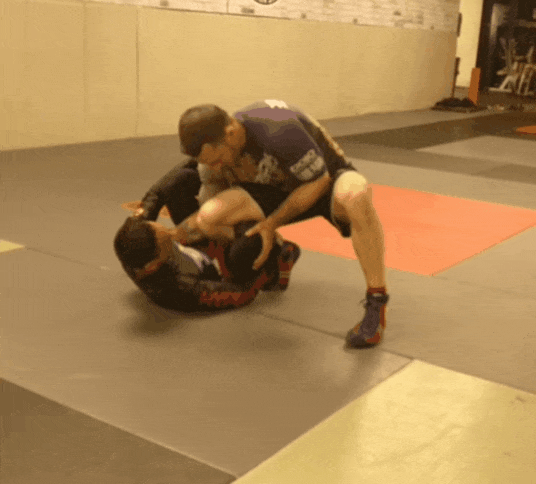As mentioned before the primary goal of the DLR hook is often considered to be turning the opponents knee inward. In contrast the RDLR hook is mainly about turning the knee outward to stop the knee cut pass. This is done with three tools, the posting leg, the hooking leg, and the grip on the foot. So when It comes to passing, we need to dismantle all three.
For most RDLR passes we need to get in close and crowd the guard player so as a result clearing the posting leg off our hip is essential. My preference if possible is to do this with the inside elbow. Once clear of the post we should be able to put some more weight into the guard player. I like to bring my trapped foot back a little to ensure that I am sitting on the hook with a good amount of weight, trapping it between my hamstring and my calf. This makes it harder for the guard player to drop the hook and reconfigure their guard or attempt sickle sweeps. Next we use the outside hand to strip the grip on the foot. With only the RLDR hook remaining, it is often easy to knee cut to finish, just make sure to collect the far side underhook first.
It isn't always possible or advisable to knee cut. If you can't clear the foot grip or you can't win the far side underhook we would like another option. At PTT Vancouver we call this pass the Chubby Checker because it involves twisting your hips. Here is a classic instructional on the topic.
If we can't clear the ankle grip that means the guard players inside hand is clearly occupied and we can freely win the head. In close to one motion we want to win the head and drop to our outside hip, stacking our outside knee beneath the guard players inside knee. Once you flop to your side you are starting a race, you win the race by turning the hips away via the grip on the far leg. Our other hand has two options, it can underhook the far leg, or it can use a Y grip on the knee. Both have advantages and disadvantages. The underhook is more stable but doesn't turn the hips as well. The Y is less stable but allows us to drive the leg further away. You can make good arguments for both but you need to have one. Once here the trapped leg is generally easy to clear.
Y grip pass.
Underhook pass








